|
|
||||||||||||||||||||||||||||||||||||||||||||||||||||||||||
|
Please sign my Guestbook and leave feedback |
||||||||||||||||||||||||||||||||||||||||||||||||||||||||||
|
Recent Additions |
||||||||||||||||||||||||||||||||||||||||||||||||||||||||||
|
Here, in a labour of love, I intend to show you most of the Boston Misericords. First of all, I ask the question - what were they doing here in the first place? This was never a monastic church, so they were not to save the poor arthritic monks during their numerous round-the-clock masses. It can only be that they were intended for the use of a choir and we know that Boston had a choir school. It must have been some choir! However, it was true that as the centuries rolled by more and more of the local bigwigs and patrons of parish churches were, in the ultimate form of one-upmanship, infiltrating the chancel area beyond the rood screen. It could be, then, that some of this lavish amount of seating was reserved for the guild masters and aristocratic patrons. This is a might body of work. Not all of the misericords are wonderful so I will be showing them as thumbnails if you then want to see a large view then click on the thumbnail itself. The misericords have numbers that relate to their descriptions in a useful if somewhat scanty leaflet. I am not going to follow the number scheme but to list the more interesting ones first. |
||||||||||||||||||||||||||||||||||||||||||||||||||||||||||||||||||||||||||||||||||||||||||||||||||||||||||
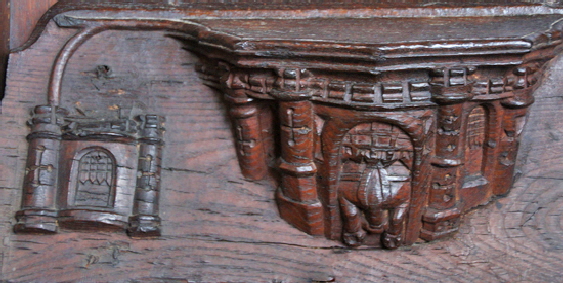 |
||||||||||||||||||||||||||||||||||||||||||||||||||||||||||||||||||||||||||||||||||||||||||||||||||||||||||
 |
||||||||||||||||||||||||||||||||||||||||||||||||||||||||||||||||||||||||||||||||||||||||||||||||||||||||||
|
Left: No. 43. George and the Dragon. The right hand supporter has been removed (why?) and the Church Guide thinks it may have been the head of a princess. Right: No 10. Sir Yvain’s horse enters an enemy castle but his unfortunate horse is cut in two by the lowered portcullis. Again, the right hand supporter is missing. Yvain was as an Arthurian knight, son of Urien and the sorceress Morgan le Fay. Sir Gawain was his cousin. There are many stories associated with Yvain that I don’t intend to paraphrase here! |
||||||||||||||||||||||||||||||||||||||||||||||||||||||||||||||||||||||||||||||||||||||||||||||||||||||||||
 |
 |
|||||||||||||||||||||||||||||||||||||||||||||||||||||||||||||||||||||||||||||||||||||||||||||||||||||||||
|
Left: No.43. Two birds share the head of a lion. The supporters are rather anaemic-looking dragons. Right: No.59. A hunter is sharpening his knife on a flint, surrounded by his hounds. |
||||||||||||||||||||||||||||||||||||||||||||||||||||||||||||||||||||||||||||||||||||||||||||||||||||||||||
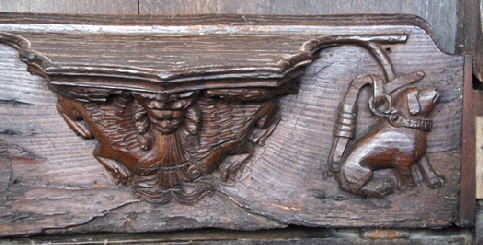 |
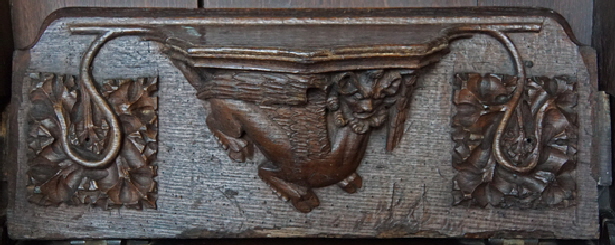 |
|||||||||||||||||||||||||||||||||||||||||||||||||||||||||||||||||||||||||||||||||||||||||||||||||||||||||
|
Left: No. 19. The Guide says this represents two winged lions with a single head. I have a feeling that is a bit simplistic as the head looks human and maybe crowned. Anyway we can agree that the supporter (the left one is missing) is a chained dog. Right: No.58. A griffin. |
||||||||||||||||||||||||||||||||||||||||||||||||||||||||||||||||||||||||||||||||||||||||||||||||||||||||||
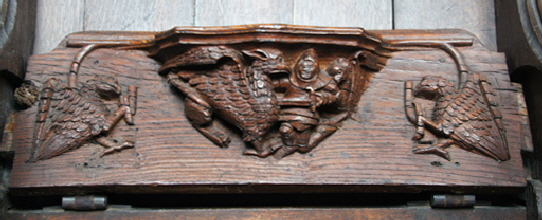 |
 |
|||||||||||||||||||||||||||||||||||||||||||||||||||||||||||||||||||||||||||||||||||||||||||||||||||||||||
|
Left: No.40. A knight is slaying a griffin while an eagle attacks him over his shoulder. The supporters have two more eagles. Right: No.35. Another favourite, this shows a bear playing an organ. Another bear works the bellows. The supporters show another bear banging a drum while another plays the bagpipes. The notion of animals playing musical instruments is a popular one in both mediaeval sculpture and in marginal illustrations of manuscripts, including the Luttrell Psalter, perhaps the finest of them all. Presumably it played to the mediaeval love of “world turned upside down” imagery. Both bears and foxes are frequent protagonists. |
||||||||||||||||||||||||||||||||||||||||||||||||||||||||||||||||||||||||||||||||||||||||||||||||||||||||||
 |
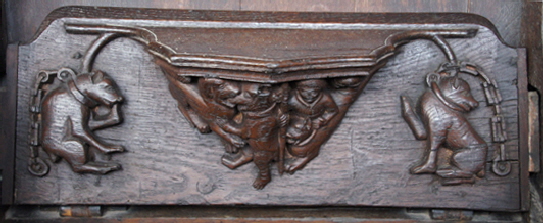 |
|||||||||||||||||||||||||||||||||||||||||||||||||||||||||||||||||||||||||||||||||||||||||||||||||||||||||
|
Left: No.50. Three dragons. Right: No.18. A bear baiting scene flanked by two more chained bears. |
||||||||||||||||||||||||||||||||||||||||||||||||||||||||||||||||||||||||||||||||||||||||||||||||||||||||||
 |
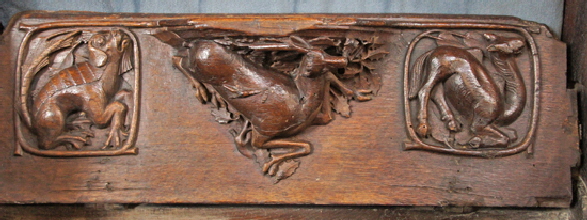 |
|||||||||||||||||||||||||||||||||||||||||||||||||||||||||||||||||||||||||||||||||||||||||||||||||||||||||
|
Left: No.16. One of the most famous of the Boston misericords. A man and his wife sit around a fire and a cauldron. The man wields the bellows and the woman a ladle and basin. The supporters are pretty weird! Right: No.4. A deer amongst foliage. The supporters are a hound and a fanciful representation of a kneeling camel! |
||||||||||||||||||||||||||||||||||||||||||||||||||||||||||||||||||||||||||||||||||||||||||||||||||||||||||
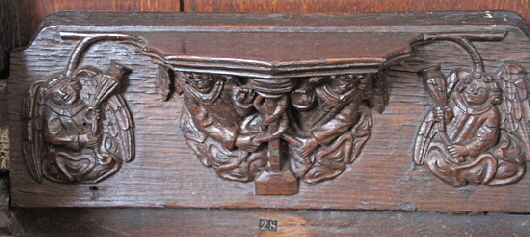 |
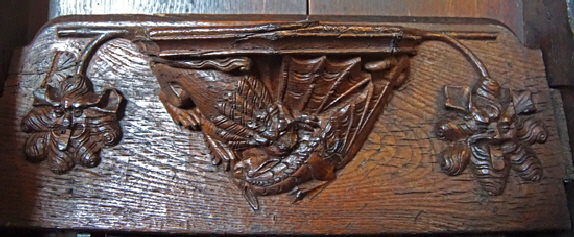 |
|||||||||||||||||||||||||||||||||||||||||||||||||||||||||||||||||||||||||||||||||||||||||||||||||||||||||
|
Left: No.28. The pillar of flagellation to which Christ was bound while he was flogged. Angels are holding the rope. The supporters are two censing angels. This is a rare example here of an overtly religious theme. Right: No.8. A lion with rather peculiar mane savages a dragon. |
||||||||||||||||||||||||||||||||||||||||||||||||||||||||||||||||||||||||||||||||||||||||||||||||||||||||||
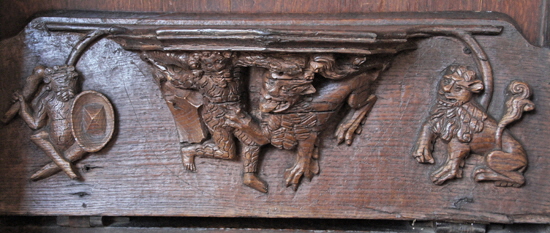 |
||||||||||||||||||||||||||||||||||||||||||||||||||||||||||||||||||||||||||||||||||||||||||||||||||||||||||
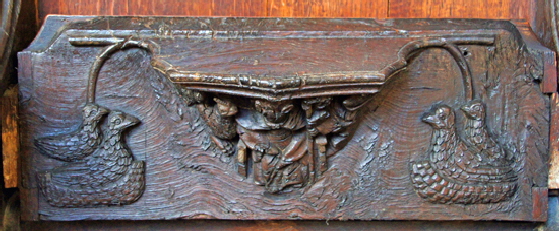 |
||||||||||||||||||||||||||||||||||||||||||||||||||||||||||||||||||||||||||||||||||||||||||||||||||||||||||
|
Left: No. 26. A wild man of the woods - or Woodwose - fights a lion with his club. To the left and right are the man and the lion prior to the battle. Right: No.25. This is another recurring piece of mediaeval satire. A wolf is dressed as a clergyman with cope and alb. He is preaching to to two foxes. To the wolf’s right is another fox - his chaplain - wears a ruff and holds a book. The supporters are hens on nests. This is almost certainly a satire on the clergy. Often it is a fox preaching to geese and it may still be so here. What do you think happens to the geese once they have been lulled into a false sense of security? |
||||||||||||||||||||||||||||||||||||||||||||||||||||||||||||||||||||||||||||||||||||||||||||||||||||||||||
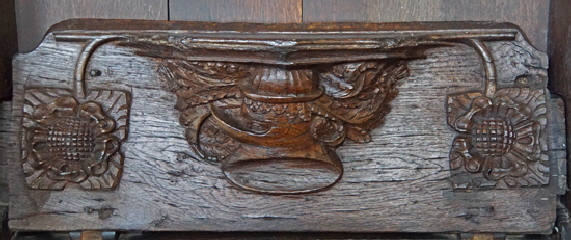 |
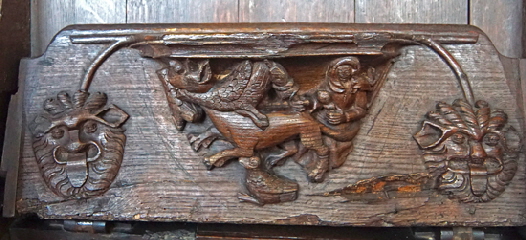 |
|||||||||||||||||||||||||||||||||||||||||||||||||||||||||||||||||||||||||||||||||||||||||||||||||||||||||
|
Left: No.15. A rather peculiar one: a curious looking military helmet with wreathes and a mantle. Right: No.17. One of the half dozen or so most popular household scenes in English churches and possibly (along with the Pelican in her Piety) perhaps the most common in misericords. A fox runs off with a cockerel pursued by a housewife clutching the distaff and spindle of her weaving. |
||||||||||||||||||||||||||||||||||||||||||||||||||||||||||||||||||||||||||||||||||||||||||||||||||||||||||
 |
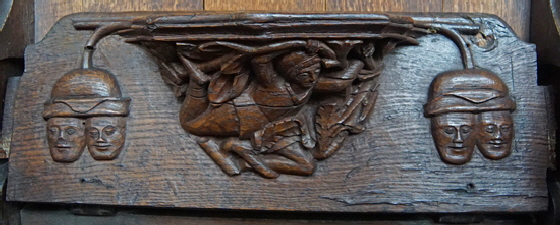 |
|||||||||||||||||||||||||||||||||||||||||||||||||||||||||||||||||||||||||||||||||||||||||||||||||||||||||
|
Left: No.41. A virgin on the right has her hand around the horn of a unicorn which feeds from her hand. Only a virgin could make a unicorn docile. According to the Church Guide this is to do with Christ becoming man and entering the virgin’s womb , only to be taken by his enemies. Hmmm. Right: No.61. A man is fighting his way through undergrowth with an axe. To his left and right the supporters have curious images of two heads under single hats. |
||||||||||||||||||||||||||||||||||||||||||||||||||||||||||||||||||||||||||||||||||||||||||||||||||||||||||
 |
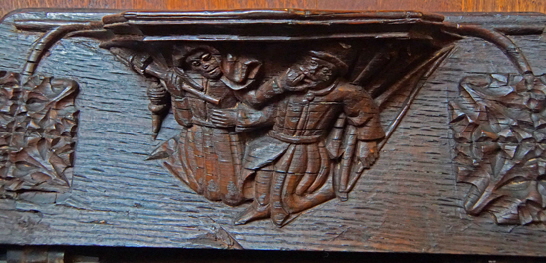 |
|||||||||||||||||||||||||||||||||||||||||||||||||||||||||||||||||||||||||||||||||||||||||||||||||||||||||
|
A tale of two hunters. Left: No. 24. A hunter about to shoot a stag with an oversized arrow, his dog at his feet. Right: No.23. A hunter, bow in his left hand, arrows under his arm is berated by his wife who has her husband by the chin and is about to strike him with her distaff. One assumes he failed to bring anything back for the pot! |
||||||||||||||||||||||||||||||||||||||||||||||||||||||||||||||||||||||||||||||||||||||||||||||||||||||||||
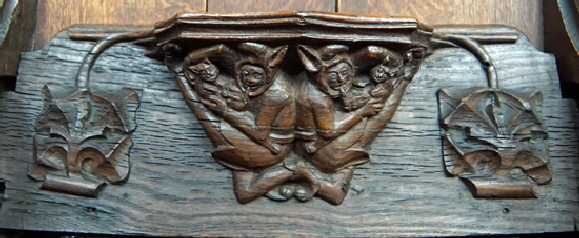 |
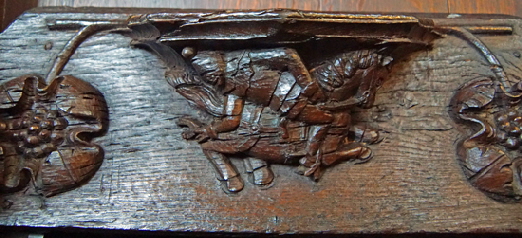 |
|||||||||||||||||||||||||||||||||||||||||||||||||||||||||||||||||||||||||||||||||||||||||||||||||||||||||
|
Left: One of the best. No.55. Two jesters back to back. Each of then is squeezing a cat under his arm and the Guide Book suggests it is a skit on the sound of bagpipes! Note the asses ears each has on his hat. Right: A curious one. No.7. A fully armoured knight is astride a horse but reaching back to retrieve a horseshoe in his right hand. What, one wonders, did he intend to do with it? Don’t try this at home! |
||||||||||||||||||||||||||||||||||||||||||||||||||||||||||||||||||||||||||||||||||||||||||||||||||||||||||
 |
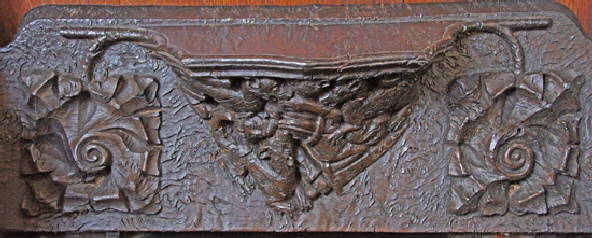 |
|||||||||||||||||||||||||||||||||||||||||||||||||||||||||||||||||||||||||||||||||||||||||||||||||||||||||
|
Left: No.9? Described by the Church Guide as a lion and a dragon kissing each other. The mind boggles. Right: No.27. This one is rather difficult to see (see below) but is very interesting. A man lies horizontal on the ground as is being attacked by wolves. He has a sword but is unable to use it. |
||||||||||||||||||||||||||||||||||||||||||||||||||||||||||||||||||||||||||||||||||||||||||||||||||||||||||
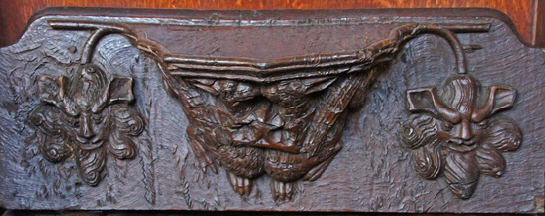 |
||||||||||||||||||||||||||||||||||||||||||||||||||||||||||||||||||||||||||||||||||||||||||||||||||||||||||
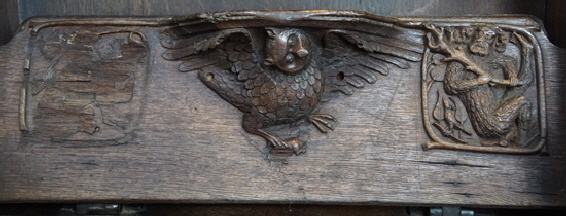 |
||||||||||||||||||||||||||||||||||||||||||||||||||||||||||||||||||||||||||||||||||||||||||||||||||||||||||
|
Left: No.34. An owl strangely crushed beneath the seat above. As well as being a symbol of wisdom, the owl was also seen a little perversely as a symbol of the Jews that were, to the Christians, unable to see in the light. To his right is a rather lovely old man of the woods or Woodwose. It is a counterpart woodwose that presumably has been obliterated as the other supporter. Quite why is a mystery. Right: No.22. Two winged monsters holding a coronet. |
||||||||||||||||||||||||||||||||||||||||||||||||||||||||||||||||||||||||||||||||||||||||||||||||||||||||||
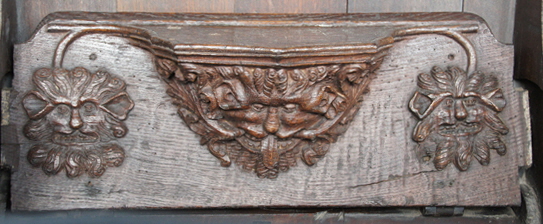 |
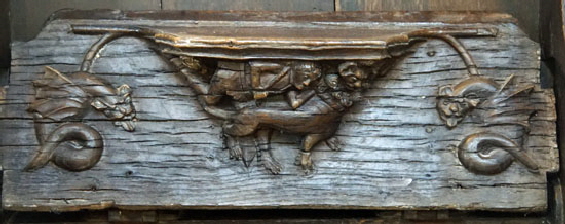 |
|||||||||||||||||||||||||||||||||||||||||||||||||||||||||||||||||||||||||||||||||||||||||||||||||||||||||
|
Left: Possibly No.56. Right: No1. A man is leaping on the back of what is probably a lion, having lassoed it. The supporters are dragons. |
||||||||||||||||||||||||||||||||||||||||||||||||||||||||||||||||||||||||||||||||||||||||||||||||||||||||||
 |
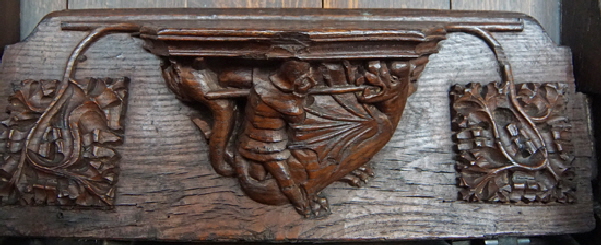 |
|||||||||||||||||||||||||||||||||||||||||||||||||||||||||||||||||||||||||||||||||||||||||||||||||||||||||
|
Left: No.60. Two winged lions with a single head, although the image is badly degraded. The supporters have hares playing pipes, as of course they are still wont to do! Right: No.19. This is described as another George & Dragon image. It might be, of course, but maybe not as there is another claimant - see top of page. |
||||||||||||||||||||||||||||||||||||||||||||||||||||||||||||||||||||||||||||||||||||||||||||||||||||||||||
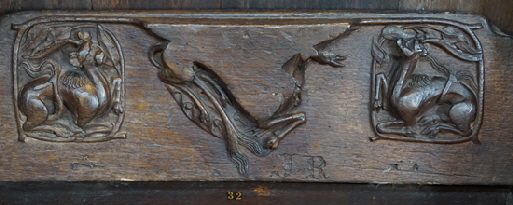 |
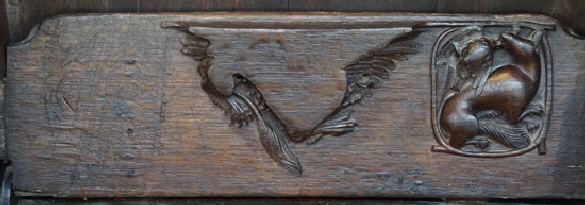 |
|||||||||||||||||||||||||||||||||||||||||||||||||||||||||||||||||||||||||||||||||||||||||||||||||||||||||
|
Numbers 31,32, and 33 are a separate range to the west of the rest, on the north side. These were the stalls used by the clergy, it seems, and they have been singled out for savage defacement. I don’t think anyone knows why. Left: No.32. Antelopes, said to represent the Old and New Testaments (why?) flank a defaced vignette. Right: No.2. The vignette was probably a griffin. Why would anyone deface it when so many griffins have been left intact? The surviving supporter shows a fox eating a hen. |
||||||||||||||||||||||||||||||||||||||||||||||||||||||||||||||||||||||||||||||||||||||||||||||||||||||||||
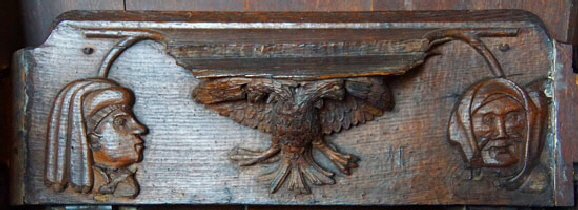 |
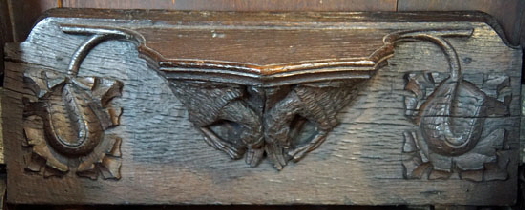 |
|||||||||||||||||||||||||||||||||||||||||||||||||||||||||||||||||||||||||||||||||||||||||||||||||||||||||
|
Left: No.12. The double-headed eagle symbol of the Hanseatic League. In an unusual departure from drollery, the supporters are a woman in profile and a man with full face. Right: No.5. Two eagles. |
||||||||||||||||||||||||||||||||||||||||||||||||||||||||||||||||||||||||||||||||||||||||||||||||||||||||||
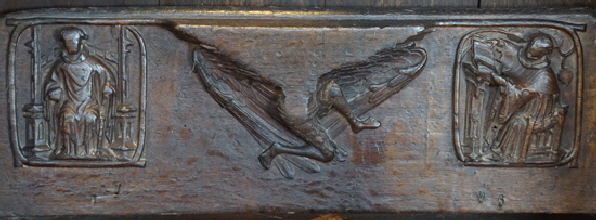 |
 |
|||||||||||||||||||||||||||||||||||||||||||||||||||||||||||||||||||||||||||||||||||||||||||||||||||||||||
|
Left: No.33. The Rector’s stall. An angel with outstretched wings has, again unaccountable, been comprehensively obliterated. A Bishop with his on his throne is on the left while the Rector is on the right reading the office. Right: No.31. An eagle. On his left a lion. |
||||||||||||||||||||||||||||||||||||||||||||||||||||||||||||||||||||||||||||||||||||||||||||||||||||||||||
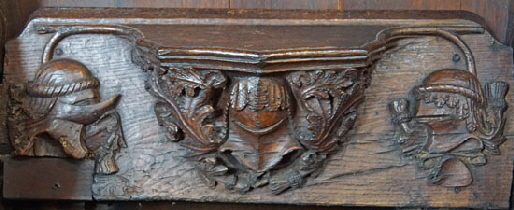 |
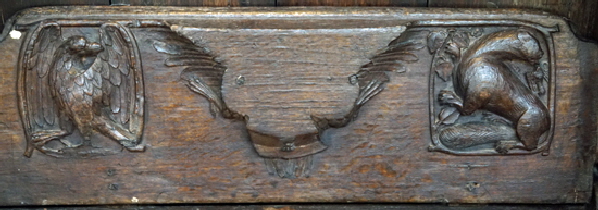 |
|||||||||||||||||||||||||||||||||||||||||||||||||||||||||||||||||||||||||||||||||||||||||||||||||||||||||
|
Left: No.6. A rather unusual foliage centrepiece is flanked by two military helmets. The one on the right is a fairly conventional knight’s helm, although the hat on top and the tassels are very strange. The left hand helmet is itself very odd with something of an eastern look to it. Right: No.3. The spread eagle has been obliterated from the centre. The supporters are another eagle and a fox finishing a meal. |
||||||||||||||||||||||||||||||||||||||||||||||||||||||||||||||||||||||||||||||||||||||||||||||||||||||||||
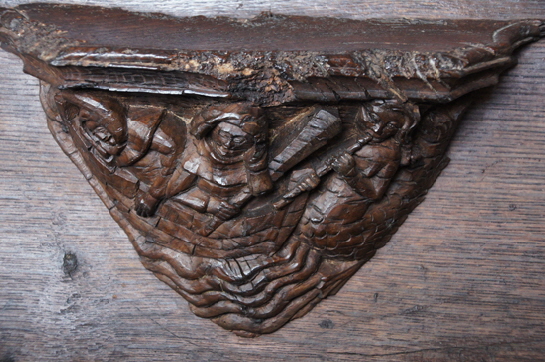 |
||||||||||||||||||||||||||||||||||||||||||||||||||||||||||||||||||||||||||||||||||||||||||||||||||||||||||
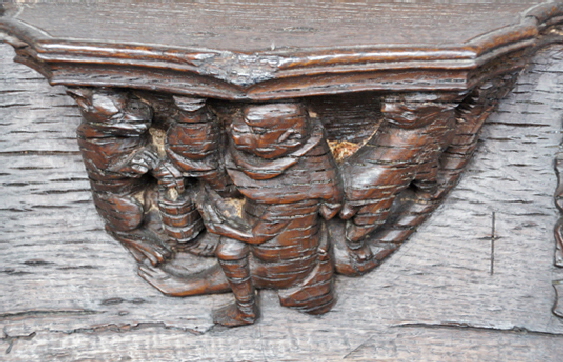 |
||||||||||||||||||||||||||||||||||||||||||||||||||||||||||||||||||||||||||||||||||||||||||||||||||||||||||
|
Left: No.13. Mermaids are a hardy perennial of the misericord range. Most large groups have one. Usually the little minx is sitting there with her breasts bared, titivating her hair with a comb, a mirror in her other hand. It is intended to demonstrate the futility of lust. Boston, predictably, has a more sophisticated image. This mermaid is a siren and she is playing a “pipe” - it looks like but can’t be a clarinet - to two sailors on the left, one of whom has an oar or steering paddle in hand. The sweetness of her music will either lure them onto the rocks or enchant them so much that they forget to eat and drink. Right: No.49. The Guide describe this drily as a baboon emptying a flask of liquid into a bucket held by a fox on his left, whilst he has another fox behind him. I believe it is a variation on a satire on the medical “profession” of the time. What the baboon is pouring is probably his own urine, a commentary on the duplicity of apothecaries and their “cures”. Again, this is a recurring theme in misericord ranges. |
||||||||||||||||||||||||||||||||||||||||||||||||||||||||||||||||||||||||||||||||||||||||||||||||||||||||||
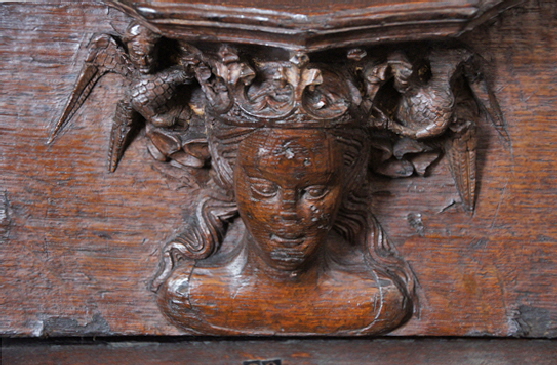 |
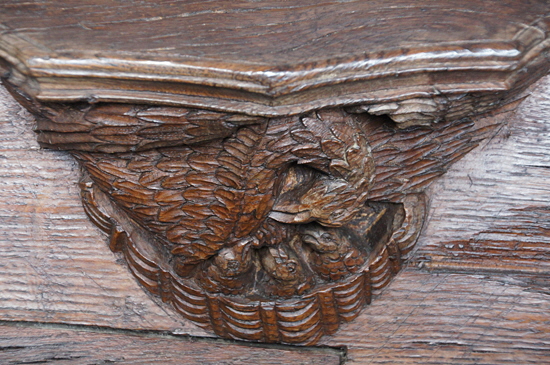 |
|||||||||||||||||||||||||||||||||||||||||||||||||||||||||||||||||||||||||||||||||||||||||||||||||||||||||
|
Left: No.29. A queen is being crowned by two bird-like angels. The Church Guide suggests this Anne of Bohemia, first wife of Richard II between 1382 and 1394. She was given the manor of Boston and in her time supported the Guild of St Mary. Such attributions are often fanciful but I believe this one. Right: No.38. Here we have the most common misericord theme: the Pelican in her Piety. It appears so many time on these pages that I really can’t be bothered to explain its symbolism again. As well as on misericords, it is a hardly perennial on the tops of decorative font covers. |
||||||||||||||||||||||||||||||||||||||||||||||||||||||||||||||||||||||||||||||||||||||||||||||||||||||||||
 |
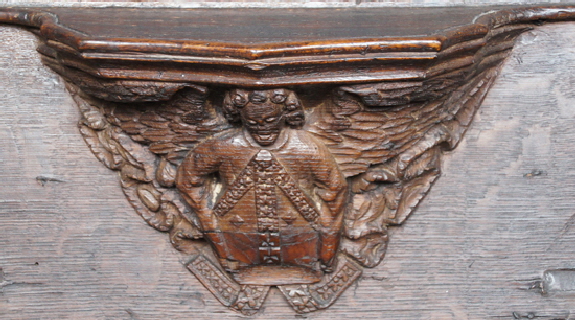 |
|||||||||||||||||||||||||||||||||||||||||||||||||||||||||||||||||||||||||||||||||||||||||||||||||||||||||
|
Left: No.43. Two eagles sharing the head of a lion. Right: No.57. An angel holding a bishop’s mitre. |
||||||||||||||||||||||||||||||||||||||||||||||||||||||||||||||||||||||||||||||||||||||||||||||||||||||||||
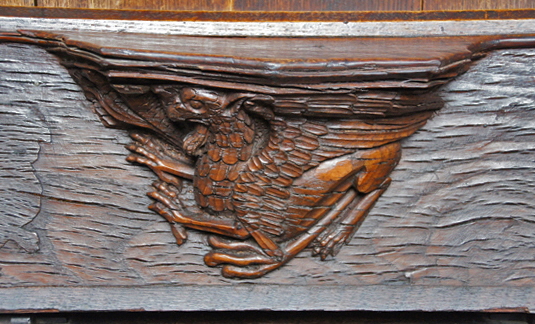 |
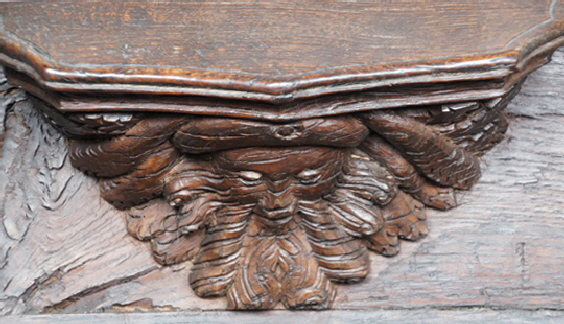 |
|||||||||||||||||||||||||||||||||||||||||||||||||||||||||||||||||||||||||||||||||||||||||||||||||||||||||
|
Left: No.58. A rather magnificent griffin. Right: No.56. A man with his beard in ringlets. |
||||||||||||||||||||||||||||||||||||||||||||||||||||||||||||||||||||||||||||||||||||||||||||||||||||||||||
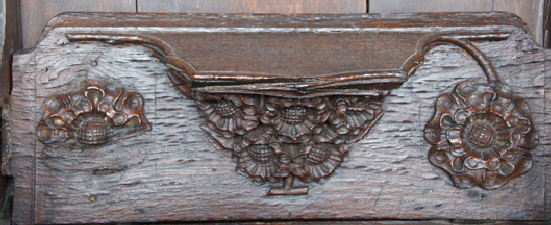 |
||||||||||||||||||||||||||||||||||||||||||||||||||||||||||||||||||||||||||||||||||||||||||||||||||||||||||
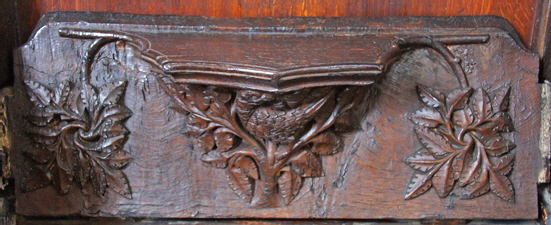 |
||||||||||||||||||||||||||||||||||||||||||||||||||||||||||||||||||||||||||||||||||||||||||||||||||||||||||
|
Left: No.30. A bird perched in a tree. Right: One of several floral designs. |
||||||||||||||||||||||||||||||||||||||||||||||||||||||||||||||||||||||||||||||||||||||||||||||||||||||||||
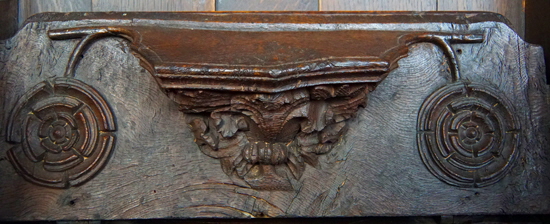 |
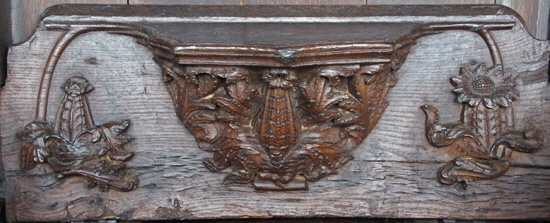 |
|||||||||||||||||||||||||||||||||||||||||||||||||||||||||||||||||||||||||||||||||||||||||||||||||||||||||
|
Left and Right: Two more floral designs. |
||||||||||||||||||||||||||||||||||||||||||||||||||||||||||||||||||||||||||||||||||||||||||||||||||||||||||
|
The Bigger Picture |
||||||||||||||||||||||||||||||||||||||||||||||||||||||||||||||||||||||||||||||||||||||||||||||||||||||||||
|
Here I show some expanded views of some of the more interesting imagery. |
||||||||||||||||||||||||||||||||||||||||||||||||||||||||||||||||||||||||||||||||||||||||||||||||||||||||||
 |
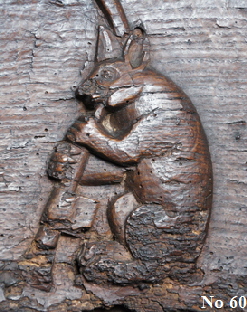 |
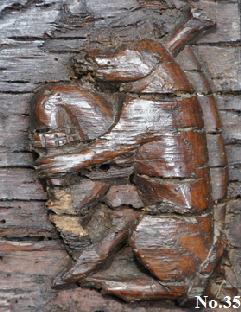 |
||||||||||||||||||||||||||||||||||||||||||||||||||||||||||||||||||||||||||||||||||||||||||||||||||||||||
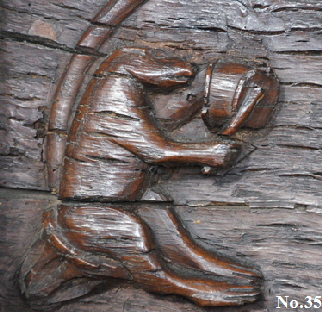 |
||||||||||||||||||||||||||||||||||||||||||||||||||||||||||||||||||||||||||||||||||||||||||||||||||||||||||
 |
||||||||||||||||||||||||||||||||||||||||||||||||||||||||||||||||||||||||||||||||||||||||||||||||||||||||||
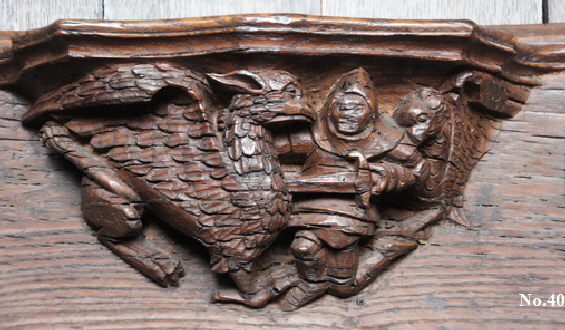 |
||||||||||||||||||||||||||||||||||||||||||||||||||||||||||||||||||||||||||||||||||||||||||||||||||||||||||
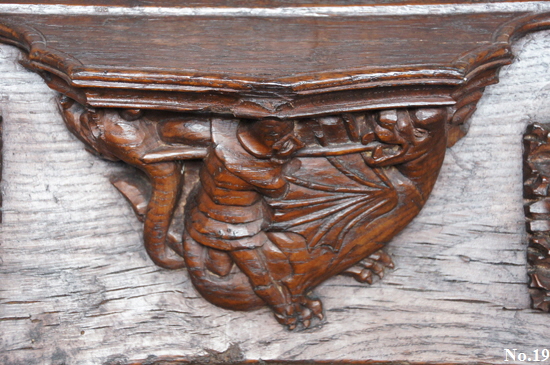 |
||||||||||||||||||||||||||||||||||||||||||||||||||||||||||||||||||||||||||||||||||||||||||||||||||||||||||
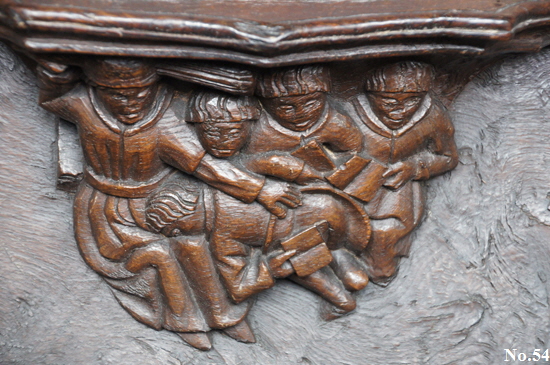 |
||||||||||||||||||||||||||||||||||||||||||||||||||||||||||||||||||||||||||||||||||||||||||||||||||||||||||
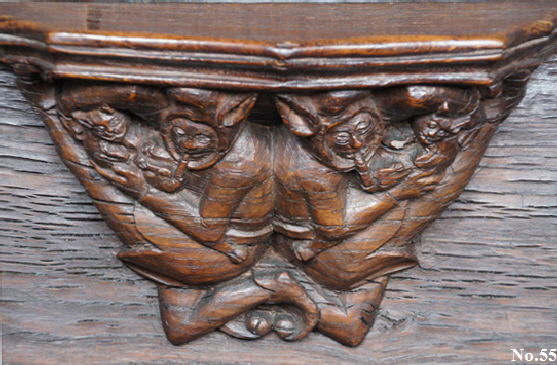 |
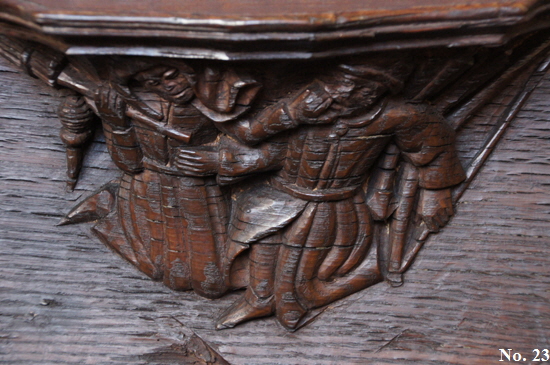 |
|||||||||||||||||||||||||||||||||||||||||||||||||||||||||||||||||||||||||||||||||||||||||||||||||||||||||
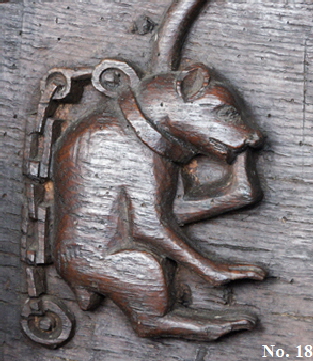 |
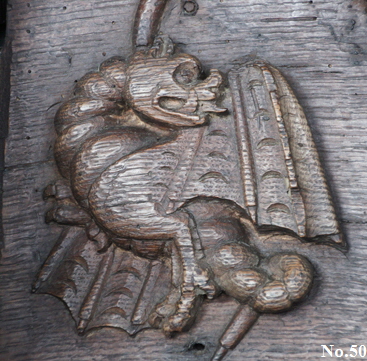 |
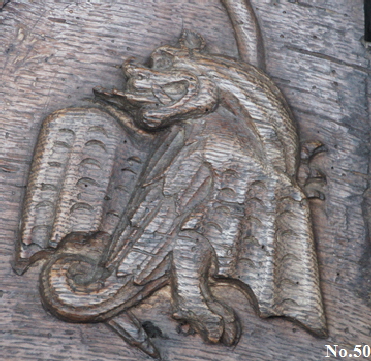 |
||||||||||||||||||||||||||||||||||||||||||||||||||||||||||||||||||||||||||||||||||||||||||||||||||||||||
 |
||||||||||||||||||||||||||||||||||||||||||||||||||||||||||||||||||||||||||||||||||||||||||||||||||||||||||
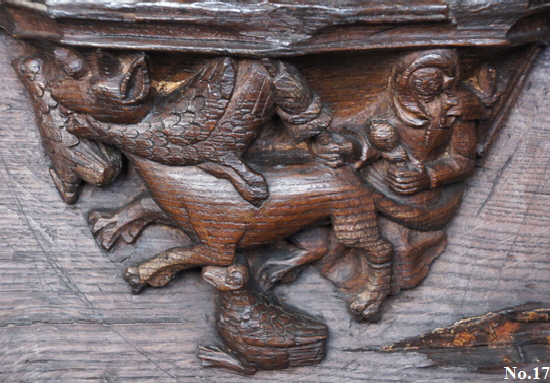 |
||||||||||||||||||||||||||||||||||||||||||||||||||||||||||||||||||||||||||||||||||||||||||||||||||||||||||
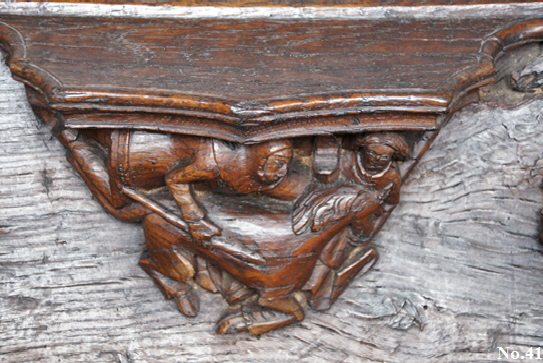 |
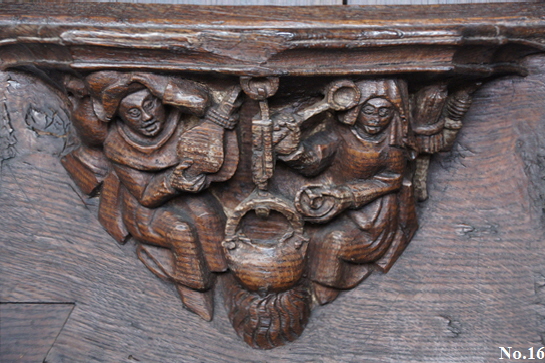 |
|||||||||||||||||||||||||||||||||||||||||||||||||||||||||||||||||||||||||||||||||||||||||||||||||||||||||
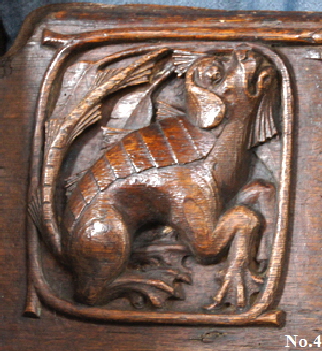 |
||||||||||||||||||||||||||||||||||||||||||||||||||||||||||||||||||||||||||||||||||||||||||||||||||||||||||
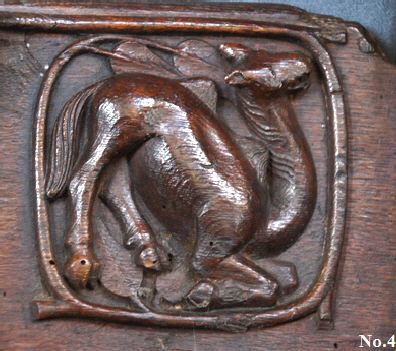 |
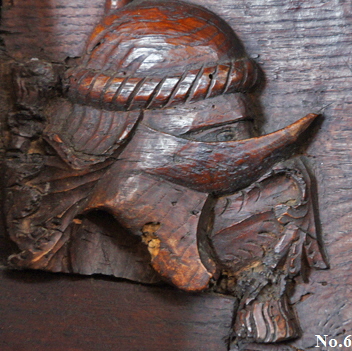 |
|||||||||||||||||||||||||||||||||||||||||||||||||||||||||||||||||||||||||||||||||||||||||||||||||||||||||
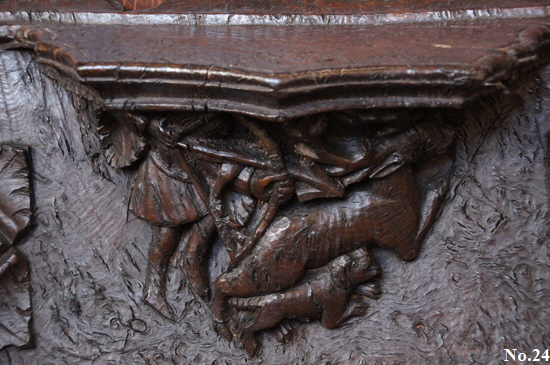 |
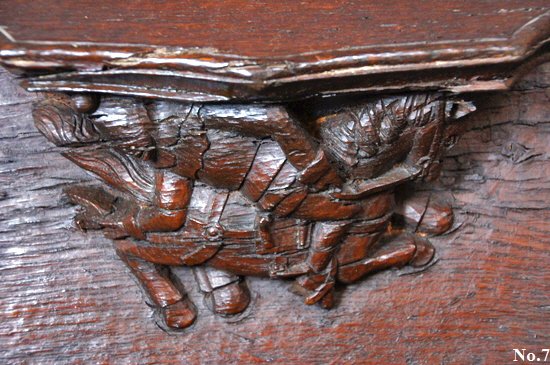 |
|||||||||||||||||||||||||||||||||||||||||||||||||||||||||||||||||||||||||||||||||||||||||||||||||||||||||
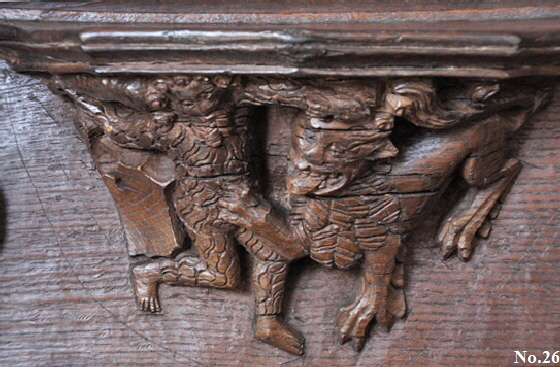 |
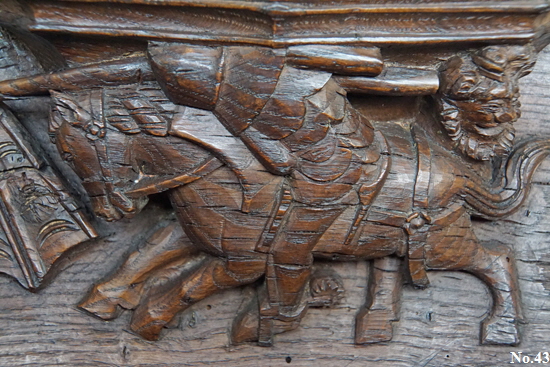 |
|||||||||||||||||||||||||||||||||||||||||||||||||||||||||||||||||||||||||||||||||||||||||||||||||||||||||
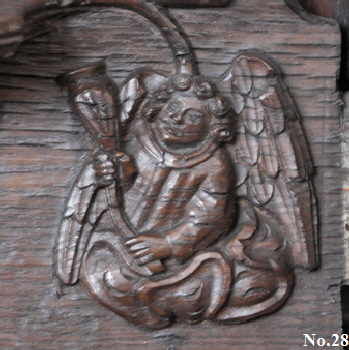 |
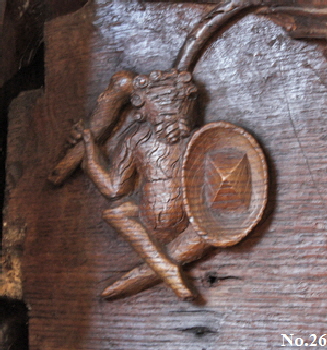 |
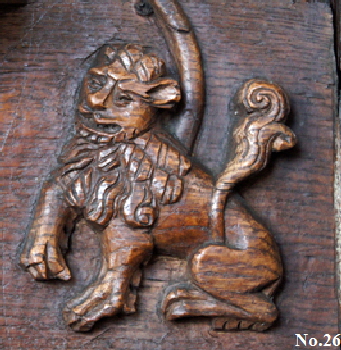 |
||||||||||||||||||||||||||||||||||||||||||||||||||||||||||||||||||||||||||||||||||||||||||||||||||||||||
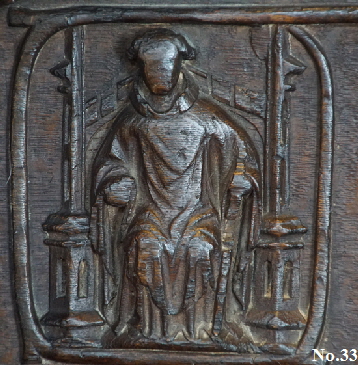 |
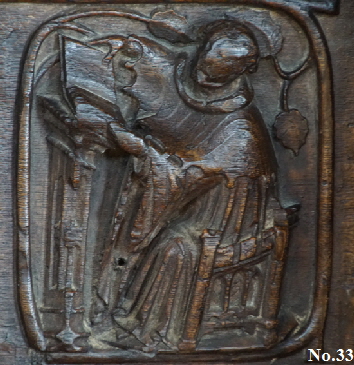 |
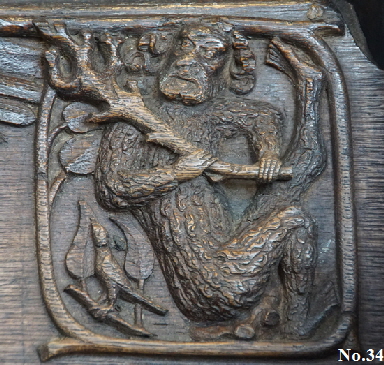 |
||||||||||||||||||||||||||||||||||||||||||||||||||||||||||||||||||||||||||||||||||||||||||||||||||||||||
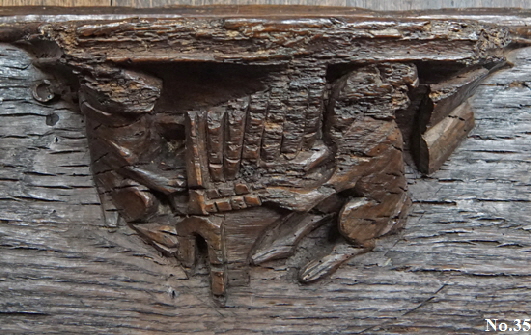 |
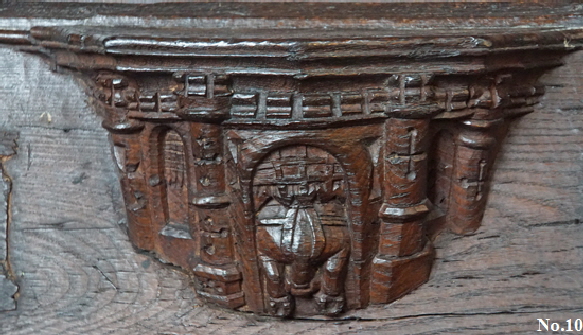 |
|||||||||||||||||||||||||||||||||||||||||||||||||||||||||||||||||||||||||||||||||||||||||||||||||||||||||
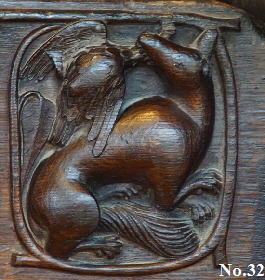 |
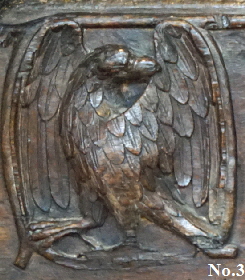 |
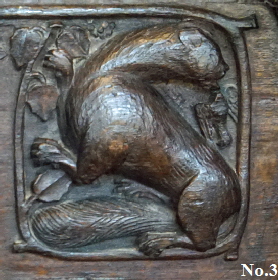 |
||||||||||||||||||||||||||||||||||||||||||||||||||||||||||||||||||||||||||||||||||||||||||||||||||||||||
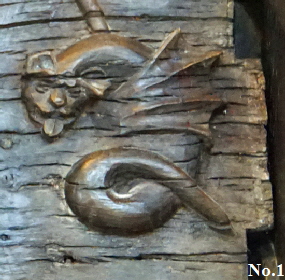 |
||||||||||||||||||||||||||||||||||||||||||||||||||||||||||||||||||||||||||||||||||||||||||||||||||||||||||